Introduction to Operations Management
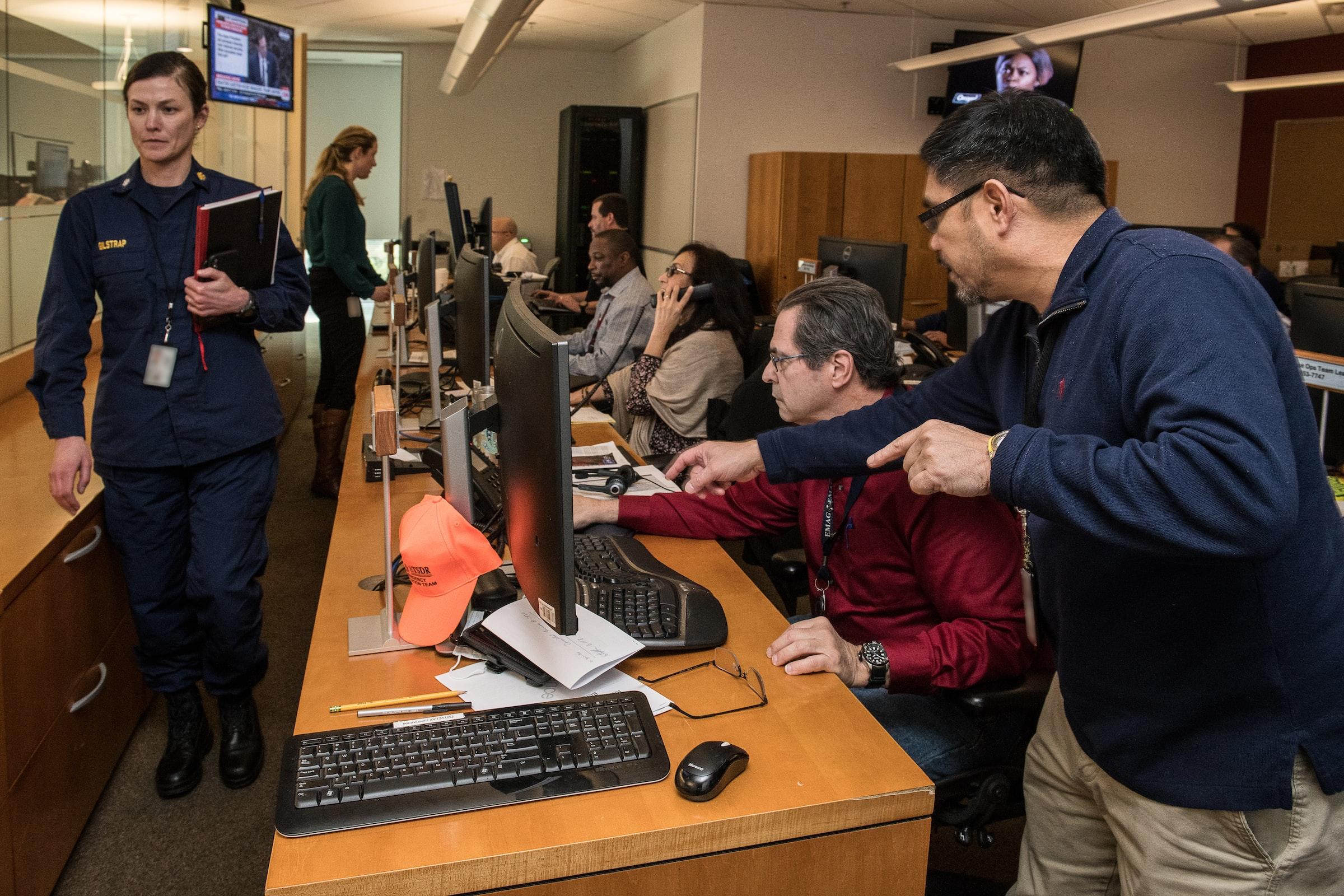
Introduction
Operations management is the management of all activities and resources that are devoted to the production and delivery of goods and services. The operations function is that part of the organization which is responsible for this activity. Before we get to the introduction to operations management, let us quickly understand the functions of an organization and the place of operations within those functions.
Functions of an Organization
Any commercial organization exists for creating wealth through profits and valuation. To do that, it must offer something valuable to the market, which is called its product. An organization has the following basic functions to conceive, create, and distribute its product to achieve the above-mentioned objectives. These basic functions are divided into core and supporting functions as discussed below.
Core Functions
Core functions are directly involved in the process of managing the product, right from its conception to distribution. Here are the main core functions in an organization. They may also be referred to as the line functions.
-
- Product Development
- Operations
- Sales & Marketing
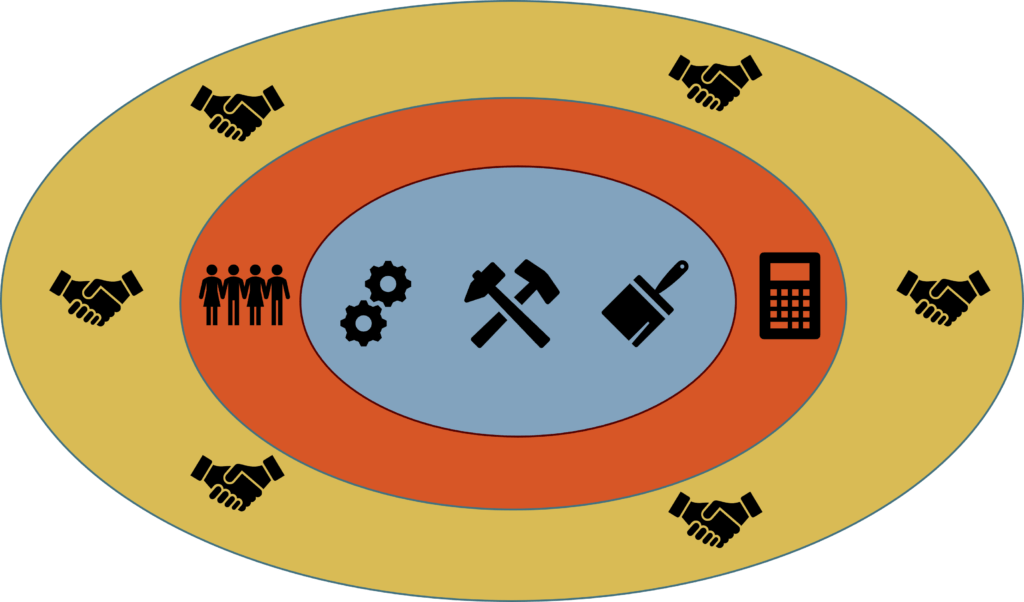
Support Functions
Support functions, as the name suggests are the activities that are not directly related to product management, but provide assistance to the core functions, enabling them to carry out their activities. The most prominent support functions in an organization are as follows. They are also called staff functions.
-
- Accounting & Finance
- Human Resources Management
Also read – Introduction to Strategic Management
Relationship Between Operations & Other Functions
Operations are the heart of any organization and have a mutually dependent relationship with the other functions in the organization. All departments of an organization depend upon each other to achieve their individual and organizational objectives. They cannot exist and succeed in isolation because their relevance is only as a part of an intertwined web of organizational functions and not otherwise. Let us quickly look at some examples of this relationship and interdependence of operations with other functions.
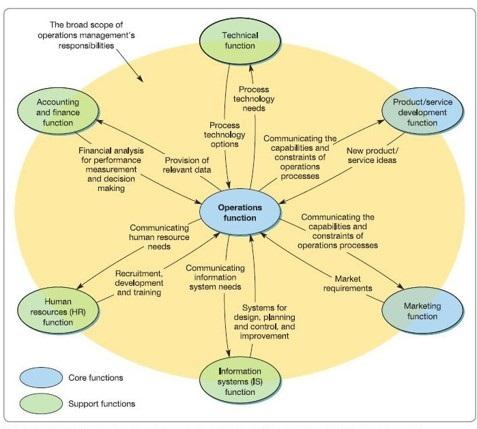
Marketing
Operations keep marketing teams updated about the capabilities and constraints of the organization’s products and its capacities. Marketing, in turn provides inputs regarding the market trends and the competitive environment to operations.
Product Development
Product development or the R&D department as it is popularly called, depends on the operations for information regarding the practical aspects of a new product. The operations also evaluate the feasibility of the product for commercial production. Operations need the help of the R&D department for new product ideas and technology updates to stay ahead in the business.
Technical
The technical function works closely with operations to upgrade and improve the process and technology and keep the organization relevant in the changing paradigms.
Finance & Accounting
Operations depend on finance and accounting to cover its day to day, and capital expenses. Finance & accounting on the other hand need inputs from operations for costing and forecasting activities.
Human Resources
Human resources and operations coordinate each other for manpower related functions. Operations communicate their talent requirement, both quantitively and qualitatively to the HR and the HR in turn ensures availability of such resources to operations, thus helping each other to conduct their activities smoothly.
Information Technology
The IT department helps operations in managing and monitoring their systems, using technology and they can do so only if operations provide them with domain specific inputs on a regular basis. Eventually, both functions strive for efficiency by coordinating with each other.
Duties & Responsibilities of Operations Manager
Introduction to operations management cannot be complete unless we talk about the duties & responsibilities the operations manager. An operations manager holds a very important position in a company and has to perform very important tasks. Some of the most important duties and responsibilities of the operations manager are listed and described below.
Understand the operation’s strategic objectives
The objectives of the operations department are a part of the larger, corporate objectives and accordingly operations strategy is formulated on the basis of the operations head’s understanding of the objectives of the operations department.
Developing an operation’s strategy for the organization
Having understood the objectives of operations, the operations manager must formulate a strategy that is effective enough to achieve those objectives. Once formulated, the operations manager also ensures that the strategy is implemented and evaluated well to ensure the objectives are achieved as desired.
Designing the operation’s products, services, and processes
Operations being a complicated process, the operations manager manages the processes for efficiency and relevance, while ensuring the safety of his people and the plant & machinery.
Planning and controlling the operations
The operations manager is responsible for planning all the activities in operations and exercising control over these activities to ensure everything runs smoothly without any problems, thus achieving the objective of the operations department.
Improving the performance of Operations
Regularly identifying areas of improvement, both in process and the training requirements of the team, is the responsibility of the operations manager. He must ensure that his plant & machinery is kept in top functioning order while also ensuring that his team members are motivated, and equipped with the latest industry skills.
Suggested Reading – 3 Golden Steps That Make Freshers Get Hired Instantly
Operations’ Transformational role
The operations department transforms input resources into finished products that have a great market value as compared to the market value of the input resources themselves. This is called the resources transformation, and in every organization, operations bring about this transformation. The input resources are classified into the following two categories.
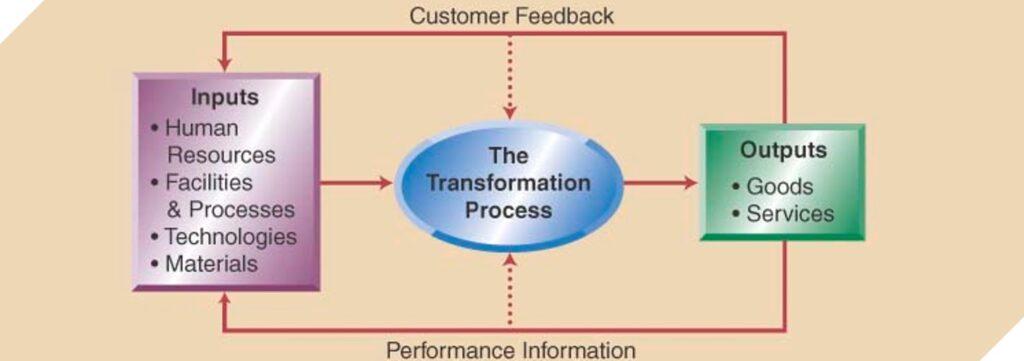
Transformed Resources
These are those input resources that themselves undergo transformation and become a part of the finished product. All raw materials fall under this category. For. e.g., aluminum sheets undergo transformation at a car plant and become part of the car body.
Transforming resources
Transforming resources do not themselves undergo transformation but assist in the process of transformation of raw material into finished products. For e.g., lubricating oil for plant and machinery helps in smooth functioning of the plant but itself does not become a part of the finished product.
Operations Output
The output of operations in any organization is the product that the business offers to its customers. The final product can either be a service, a good, or a combination of goods and services. A furniture manufacturing company produces mostly a goods product, a bank on the other hand, offers mostly a service product, and a restaurant offers a product that is a combination of goods and services.
Differences Between Goods and Services
-
- Goods are tangible, services are intangible and that is the most basic difference between the two.
- Goods can be stored and inventoried, whereas services are highly perishable and if not consumed, are lost forever.
- Production and consumption are separated and the customer involvement in the production process is nil to low in goods, while in the case of services, they are generated in the presence of the customers and consumed instantaneously by them.
- You can transport goods from one place to another for consumption, but the services must be produced at their place and time of consumption.
- The quality of the goods is evident and can be tested but the quality of services can be judged only after purchasing while consuming them.
Similarities between goods and services
Since both goods and services are two different components of a product, they do have some similarities as well. These similarities are as mentioned below.
-
- They both use technology.
- Quality, productivity, and response time issues are witnessed in both goods and services.
- Each type of product faces capacity, layout and location constraints.
- Both need customers and suppliers to exist and function properly.
- Both services and goods products are influenced by scheduling and staffing issues.
Activities of OM
Let us briefly look at the broad spectrum of activities and tasks performed by the operations department in an organization.
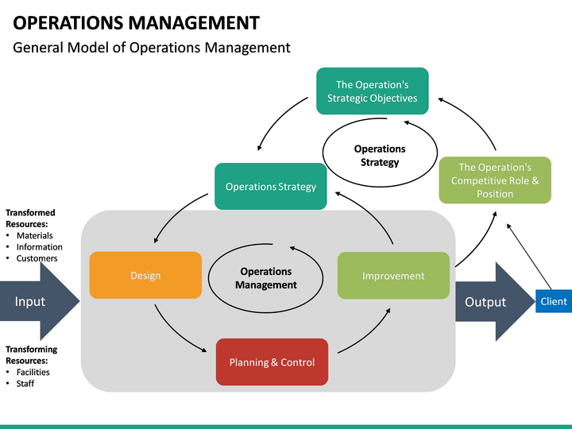
Transformation
As mentioned above, transformation of input resources into finished product is the main activity of operations management.
Planning & Control
In order to achieve the above, the managers at operations management constantly plan for resources, work on policies and procedures, safety and security, and finance. Scheduling is also in important planning activity done by the operations management.
Design
In sync with the R&D department, the operations management constantly strives to improve the design of its products and process, to ensure that the product is able to meet and beat the competition and the process are incorporating the latest developments in the field.
Improvement
Continuous improvement in people management, manufacturing techniques, and product design also form an important aspect in the day-to-day functioning of the operations management.
Operations strategy
Formulation and implementation of operations strategy to contribute towards the achievement of corporate objectives is important from the strategy perspective and it preserves the relevance of operations in the organization.
Historical Development of OM
The following table shows the historical development of operations management and the various stages it has been through to what we see it today.
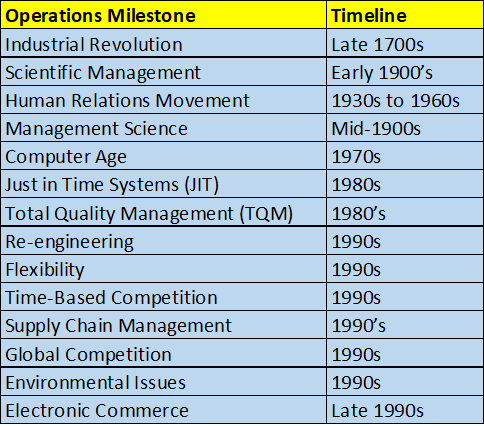
Today’s OM Environment
In the modern times, operations management operates keeping in mind the following dimensions of business and markets.
-
- Customers demand better quality, faster deliveries, and lower costs.
- Increased cross-functional decision making.
- Recognized need to better manage information using ERP and CRM systems.









